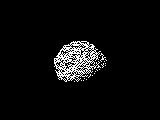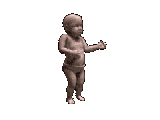
Course Syllabus--Spring 1999
Eng 373: Science Fiction and Fantasy
-----The Space of Contemporary Allegory
Professor: D. F. Felluga
Office Hours: T,Th 1:00-2:30
HEAV 430; telephone: 43770
E-mail:
felluga@omni.cc.purdue.edu

Course Description
This course will posit that speculative fiction represents one of the only still viable generic forms that deals with the present in an allegorical form. Starting from this premise, we will address a number of issues in contemporary culture through the fictions we will be reading and viewing on screen, specifically postmodernism, our contemporary carceral culture, politics and power, the Holocaust, and late capitalism. I will suggest, in other words, that speculative fiction gives us a special access to the ways we make sense of the world in our everyday lives. By pushing to the limits such issues as subjectivity, temporal sequentiality, and representation, speculative fiction can uncover the ways ideology, narrative, and epistemology function on a day-to-day basis. In short, as we progress through this semester we will be taking "science fiction" seriously and will consequently be dealing with a number of "serious" issues that concern us in our contemporary culture.
There is also a Web page that will serve as a studying resource; it includes a list of definitions for terms that we discuss in class. It can be found at the following URL:
http://omni.cc.purdue.edu/~felluga/guidesf.html.

 CELL ONE:
CELL ONE: 
NARRATIVE AND REPRESENTATION:
THE LIMITATIONS OF HUMAN CONSCIOUSNESS
In these first four weeks, I will introduce students to the basic structures of narrative form, specifically the distinction between story and discourse and between the proairetic and hermeneutic codes of narrative. A number of pop cultural shows and experimental films will serve to help us in our exploration of the narrative limitations of human consciousness.
Tuesday, January 12
Thursday, January 14
Tuesday, January 19
Thursday, January 21
Tuesday, January 26
Thursday, January 28
Tuesday, February 2
Thursday, February 4
ADDITIONAL MATERIAL:

 CELL TWO:
CELL TWO:
MONSTERS, CYBORGS, AND THE HUMAN
 In this next block of classes, we will
read arguably the first science-fiction story, Mary Shelley's Frankenstein.
It is not a coincidence, I will argue, that this tale appears at the very cusp
of the industrial revolution and, thus, at the advent of our own capitalist,
scientific, post-Enlightenment culture. In many ways, Frankenstein represents
one of the first and best examples of the use of speculative scenarios to explore
issues relavent to contemporary culture. I will introduce students to the important
concepts relavent to the Englightenment and Romanticism since these concepts
and issues continue to play an important role in all fiction to follow. (It
is not a coincidence, for example, that William Gibson's most influential novel
is titled Neuromancer.) Given the incredible structural complexity of
Shelley's tale, we will also be able to continue our discussions of narrative
form.
In this next block of classes, we will
read arguably the first science-fiction story, Mary Shelley's Frankenstein.
It is not a coincidence, I will argue, that this tale appears at the very cusp
of the industrial revolution and, thus, at the advent of our own capitalist,
scientific, post-Enlightenment culture. In many ways, Frankenstein represents
one of the first and best examples of the use of speculative scenarios to explore
issues relavent to contemporary culture. I will introduce students to the important
concepts relavent to the Englightenment and Romanticism since these concepts
and issues continue to play an important role in all fiction to follow. (It
is not a coincidence, for example, that William Gibson's most influential novel
is titled Neuromancer.) Given the incredible structural complexity of
Shelley's tale, we will also be able to continue our discussions of narrative
form.
Tuesday, February 9
Thursday, February 11
Tuesday, February 16
Thursday, February 18
Tuesday, February 23
Thursday, February 25
Tuesday, March 2
Thursday, March 4
Tuesday, March 9
Thursday, March 11
ADDITIONAL MATERIAL:

 CELL THREE:
CELL THREE:
NONFUNCTIONAL:
MARCH BREAK

 CELL FOUR:
CELL FOUR: 
POWER AND PARANOIA:
UNDERSTANDING IDEOLOGY AND SUBJECTIVITY
In this third week, I will explore some of the elements that constitute our contemporary form of social control. Michel Foucault's important social history, Discipline and Punish, will help us to understand what he terms our "carceral culture," in which government and police achieve ever greater powers in accessing the most private spheres of our lives and in which we are led to internalize governmental power structures. What are the advantages and disadvantages of such a system? Behind both Foucault's theories and George Orwell's 1984 lies the Holocaust, which could be said to mark the break between postmodernism and what came before, the moment after which one could no longer uncritically accept such Englightenment values as progress, scientific exploration, democracy, rationality, and efficiency.
Tuesday, March 23
Thursday, March 25
Tuesday, March 30
Thursday, April 1
Tuesday, April 6
Thursday, April 8
Tuesday, April 13
Thursday, April 15
ADDITIONAL MATERIAL:

 CELL FIVE:
CELL FIVE:
WHAT IS POSTMODERNISM?
In these final weeks, we will explore in detail the delineaments of our own culture through science fiction. Our age has been termed the postmodern age. We will attempt to figure out what constitutes that age, including computer culture, image culture, media culture, pop culture, and multiculturalism.
Tuesday, April 20
Thursday, April 22
Tuesday, April 27
Thursday, April 29
ADDITIONAL MATERIAL:
: BE SURE TO BRING EXAM BOOKLETS TO THE FINAL EXAM AND BEST OF LUCK!
|
|
||
|
|
|
|

Undergraduate Guide to Critical Theory
Last Revised: April 9, 1999
Images courtesy of
Media Builder